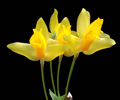|
|
|
|
|
| |
Flasks of
Lycaste aromatica 'MC6139' × sib 'MC6127' |
|
| |
|
|
| |
| Number: |
TN7556 |
| Name: |
Lycaste aromatica 'MC6139' × sib 'MC6127'
|
| Type: |
sib (What's that?) |
|
Click to Enlarge

Pod Parent Blooming Plant |
Click to Enlarge

Pod Parent Flower |
Click to Enlarge

Pollen Parent Flowers |
|
|
|
| |
Comments: Pod parent plant: One of the offspring from our TN3655 effort of 2003. Very fragrant, like red-hot cinnamon candies.
Pollen parent plant: One of the offspring from our TN3655 effort of 2003.
For additional origin/habitat information supplied courtesy of
Charles and Margaret Baker, see further below, near the bottom of this page.
|
Temperatures we attempt to use in the lab & greenhouse:
| For Species: |
|
Spring, Summer, Autumn: days average 79°F, nights 64°F; best fit is Intermediate 83-60°F
(Source:
Baker's Web OSC) |
| For Species: |
|
Winter: days average 76°F, nights 56°F; best fit is Cool-Intermediate 75-58°F
(Source:
Baker's Web OSC) |
|
About the name...
| Etymology of |
aromatica |
|
From latinized Arabic "aromaticus" fragrant, aromatic.
(Source:
Mayr & Schmucker 1998) |
| Etymology of |
Lycaste |
|
The beautiful sister of Helen of Troy, Lycaste.
(Source:
Pridgeon 1992) |
| Pronunciation of |
aromatica |
|
ah-row-MAH-ti-ka
(Source:
Hawkes 1978) |
| Pronunciation of |
Lycaste |
|
lie-CAST-ee
(Source:
Pridgeon 1992) |
|
If you would like to direct someone to this web page, please copy and paste this URL into your email:
http://troymeyers.com/d?017556
| Flask Information |
| Availability: |
We have sold all of the flasks for this item. |
| You should: |
Consider getting individual plants or compots instead of a flask.
You can place a "Notify Flask Recipients" Request, and either we or a flask recipient may contact you when plants are available.
You may also place a "Notify Retries" Request, and if an identical pollination (the same parents) is done again, we'll let you know.
You may reserve a flask, but it's very unlikely you'll get one ...this could only happen if we found a flask that we didn't know we had. |
| Yield Estimate: |
390 plants (based on flask surveys done 11/04/2014 through 01/26/2016)
|
| Plantlet Sizes: |
From many flasks 40 - 80 mm plants (based on flask surveys done 06/17/2015 through 07/08/2016)
From one most recently surveyed flask 40 - 80 mm (07/08/2016)
|
|
You might also want to:
|
View the seed assay for this item.
View items of the same species.
View items of the same genus.
|
| Ordering Information |
| You are not currently logged in. |
|
You must be a registered user and be logged in to reserve a flask or place a notification request. Please log in:
|
|
|
|
|
|
| |
The origin/habitat information below is supplied courtesy of Charles and Margaret Baker
The following information is based on the name of the plant provided by the donor, and assumes that the name is correct. If the plant has been misidentified, then the following information may not be correct.
This text is copyrighted by the Bakers and may not be reproduced without permission.
ORIGIN/HABITAT: Mexico, Belize, Guatemala, Honduras, and Nicaragua. Plants
are usually found in the mountain watersheds that drain into the Gulf of
Mexico and the Caribbean. Williams (1951) reported that this species was
found in Mexico in the States of San Luis Potosí, Tamaulipas, Vera Cruz,
Puebla, Guerrero, and Colima and indicated that distribution extended into
Guatemala, Belize (British Honduras), and Honduras. Subsequent discoveries
added Nicaragua to the habitat, and Fowlie (1970) reported that the
species is fairly common in the mountains north of the Ocotal-Jalapa
Highway at about 4900 ft. (1500 m). Plants usually are found along rivers
in damp forests on trees and rocks at 2950–4900 ft. (900–1500 m). In
Mexico, plants are found as high as 6000 ft. (1830 m) near Tuxtla
Gutierrez and as low as 500 ft.(150 m) in the State of Vera Cruz.
More about this information and the Bakers...
|
|
|
| |
|
|
|